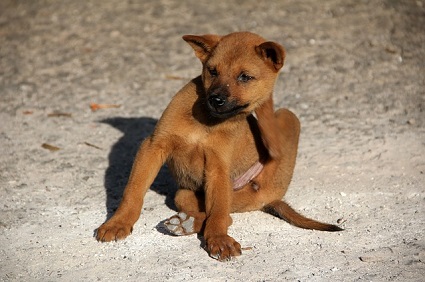Pet Lovers
11/22/2021
5 Reasons We Love Working with Pets
We often hear employees of Holiday Barn Pet Resorts say, “This is my dream job!” I say it too. Only…
Monday – Friday
7:00 am – 7:00 pm
Saturday
7:00 am – 6:00 pm
Sunday
9:00 am – 6:00 pm
Monday – Friday
7:00 am – 7:00 pm
Saturday
7:00 am – 6:00 pm
Sunday
9:00 am – 6:00 pm

Every fall, I start sniffling and sneezing around the middle of August and continue right on through October. Hay fever, they call it. I call it miserable. It’s because this is the time of year when Ragweed is at its peak. Oh, there are other things that cause allergic reactions in the fall, but Ragweed is king. But here’s something interesting… My dog gets hay fever during this time of the year too! So, I’m sniffling and sneezing, and my dog is scratching, chewing his feet, and rubbing his face on the carpet. We’re a fine pair.
As it turns out, dogs are prone to many common fall allergies. Certain dog breeds are more prone to developing hay-fever type allergies, some of which are Poodles, Schnauzers, West Highland terriers, Boston terriers, Scottish terriers, Dalmatians, and Irish Setters. This is not a complete list by far. Poor things… I mean, they’re right there on the ground walking in it. In my case, it’s blowing in the wind and I’m breathing it. My dog walks in it and breathes it! That is why you’ll likely see your dog’s reaction to hay fever over his entire body, not just the mucous membranes. Their whole body will itch, sometimes breaking into a rash. Although he may get runny eyes and nose too, these symptoms are less common in dogs.
Goldenrod gets blamed for many allergic reactions, but doctors (and veterinarians) are quick to defend this pretty golden flower. It blooms at the same time as ragweed and is more visible because of its bright color, but it’s the only fault is that it grows alongside the nasty ragweed. The main reason goldenrod is not blamed for allergies is because it does not generate airborne pollen that generally triggers allergic reactions. As a matter of fact, some dogs actually eat goldenrod to settle an upset stomach as years ago the plant was used medicinally to treat intestinal disorders and colicky babies. How do dogs know that stuff?!?
Mold is one of a dog’s most common allergens. When we have a warmer than usual fall, it sets us up for a bumper crop of mold during September, October, and possibly even into November. Not only is the unusually warm weather to blame, but mold is prevalent every fall in outdoor piles of leaves and other types of decaying plant material. Mold forms spores, and once airborne, it’s brutal for allergies – to dogs and humans.
Did you know that the worst time for fleas is September, October, and November? Most people think that fleas are more of a springtime nuisance, but one vet reports that fleas are 70% more prevalent in the fall than in the spring. He theorizes that the “flea surge” occurs because in the fall there is generally an increase in precipitation and yet temperatures stay around 70 degrees…Fleas thrive in these conditions. Flea allergies are very common in dogs. I had a beagle who was allergic to fleas. Every single year, around September, she would bite at a spot above her tail until all of the hair was gone… it looked like she had a little dip on her back. The vet said it was a flea bite allergy. Sure, the same thing could have happened in the spring or summer, but she never had an allergic reaction until the fall, when, as we have now learned, fleas are rampant.
We can’t dismiss dust mites as a common fall allergy too. Obviously, dust mites are present all year long, but they get really stirred up the first time you turn your heat on in the fall. From 30 to 80 percent of allergic dogs and cats test positive for dust mite sensitivity.
Your veterinary is the very best place to start if you fear your dog is having allergic symptoms. Just like for us, there are anti-histamine and immune-boosting medications available to help your dog get through the season as comfortably as possible.
One of the best things you can do for your dog is to keep him as clean as possible. Bring him to the Holiday Barn Pet Resorts Spa for a weekly bath to help wash pollen particles away from the skin. We have some wonderful products to help soothe and nourish his aggravated skin. During the rest of the week, brush your dog daily. When your dog comes in from outside, wipe his entire body down with a damp towel, spending a little extra time around the face and ears. Many times we allow our dog’s coat to grow longer when summer is past. If your dog is the kind who gets haircuts on a regular basis… ShihTzus, Lhasa Apsos, Schnauzers, Poodles, for example, it’s better to keep his hair trimmed through-out the fall months so he is less likely to drag allergens in the house, and you’re able to clean him more thoroughly.
There’s also an excellent article by “Canine Skin Solutions” that identifies the top 5 allergen groups that can cause your dog to have an allergic reaction year-round. It also provides tips on how to counteract your dog’s chances of reacting to each particular group.